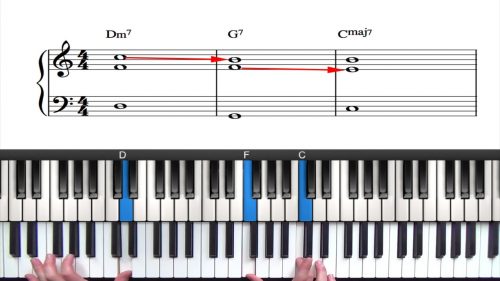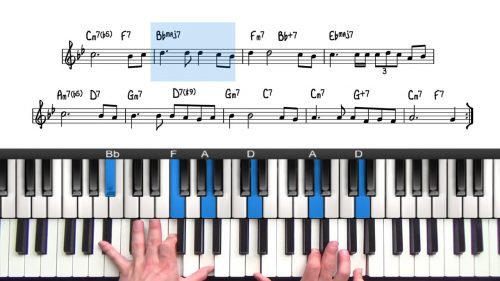"My Foolish Heart" Summary
Welcome to the final lesson in our beginner exploration of the jazz standard "My Foolish Heart." As we play through the song, I’ll share my thoughts on how I interpret the information on the lead sheet to choose suitable voicings options.
This lesson aims to illustrate the thought process behind choosing voicings, interpreting melodies, and making real-time decisions when playing from lead sheets.
Identify 251 Progressions
Recognising common progressions such as 2-5-1s and incomplete 2-5s is an important skill for jazz musicians. Quickly identifying these related blocks of harmony allows us to visualise the upcoming voicings shapes, voice leading, and hand movement which helps to maintain steady flowing chords that are cleanly and smoothly connected.
Spread Voicings vs. Left Hand Shells
The focus of the lessons in our Novice section is to develop your ability to play spread voicings. However, in some instances left hand ‘shell voicings’ (R-7 or R-3-7) are a more appropriate choice. These left hand voicing configuration is particularly well suited to a busy melody line – ie. lots of notes in a bar – and the shell voicings allow the left hand to take control of the harmony whilst the right hand can focus on the melody and/or adding additional melodic embellishments.
Phrasing & Embellishment
The melody as written on the lead sheet is just 1 of a potentially infinite number of ways that we can phrase the melody. As the arranger, we are in control of dynamics (loud vs. soft) and also how we phrase the melody.
‘Pulling and pushing’ on the timing can help to create a more emotive arrangement and more closely mirror a vocal rendition. In this lesson we discuss how to give the melody space to breathe and how to add dynamics and expression such as building up towards a climax.
Practice Tips
-
Listen to Vocal Versions: Study vocal renditions of "My Foolish Heart" to improve your sense of phrasing. For every jazz standard that you are working on, find at least 1 vocal version that you admire and try to emulate exactly how the singer phrases the melody. This will help your melodies to 'sing' instead of sounding robotic.
-
Experiment with Dynamics: Experiment with the volume and also the tempo by speeding up and slowing down. This can help build tension and create a more emotive performance. Adding grace notes and tempo variations can add a lyrical quality to our playing, mimicking the dynamics and expressiveness of a vocalist.
- Anticipate Movements: Practice recognising and anticipating common chord progressions and related blocks of harmony such as 2-5-1s and 2-5s. This will help you to make smoother transitions as you play through the chord changes. With time and practice, this process becomes intuitive and instinctive.






